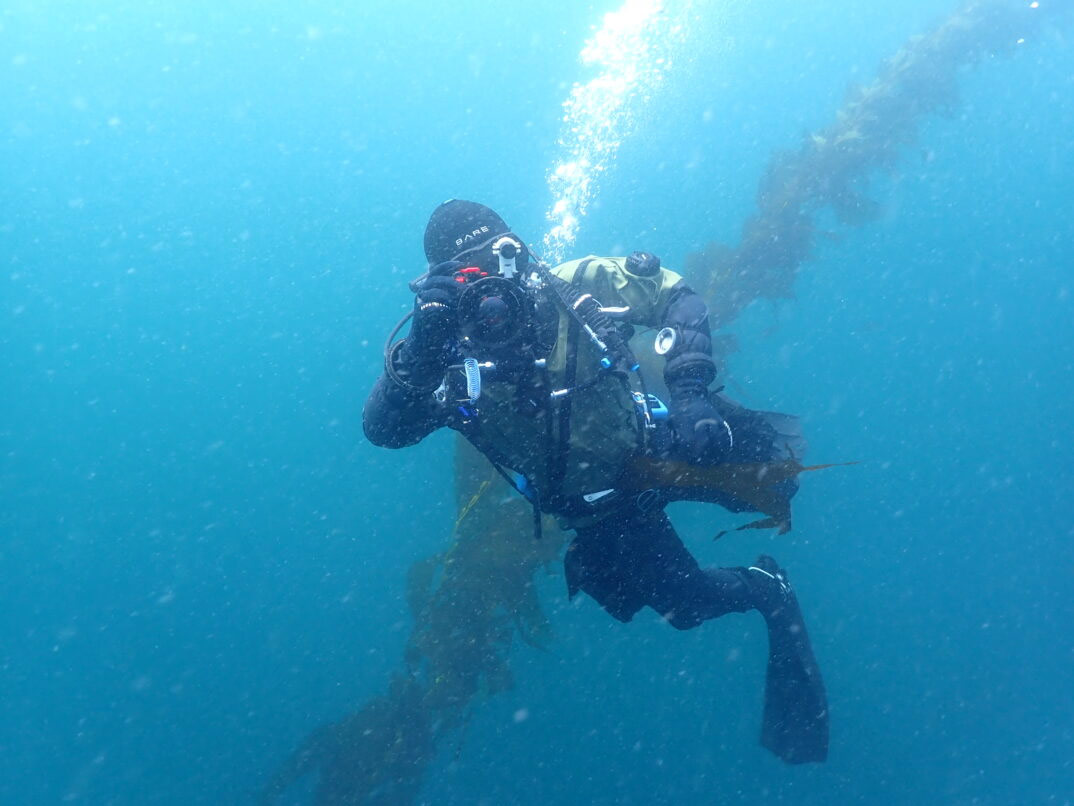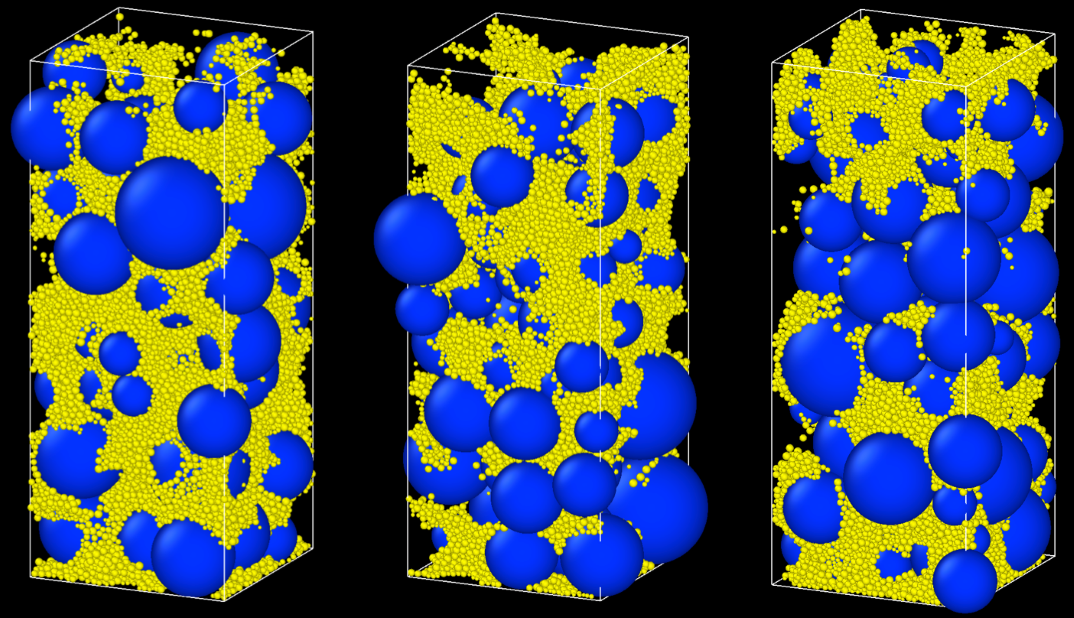Our exciting projects include:

Thin-Film Evaporation for High Power-Density Electronics Cooling
This project aims to probe the fundamental kinetic limit of thin-film evaporation, a regime predicted to sustain extremely high heat fluxes but not yet realized experimentally due to practical constraints, including the lack of suitable evaporator architectures, pore clogging, limited liquid replenishment, parasitic thermal resistances, and premature dry-out. Governed by interfacial transport and phase-change kinetics at the liquid–vapor interface, thin-film evaporation offers a fundamentally higher performance ceiling than boiling-based heat transfer. Through systematic geometric and materials design of micro- and nano-structured membranes, this work seeks to isolate intrinsic evaporation physics and approach the kinetic limit, thereby establishing a new fundamental upper bound for passive, high–power-density thermal management approaches.
T. Feng, Y. Pei, H. Zhang, B. Asai, G. Dong, A. Joshi, A. Saha, S. Cai, R. Chen, “High-flux and stable thin-film evaporation from fiber membranes with interconnected pores,” Joule 9, 101975, July 2025.
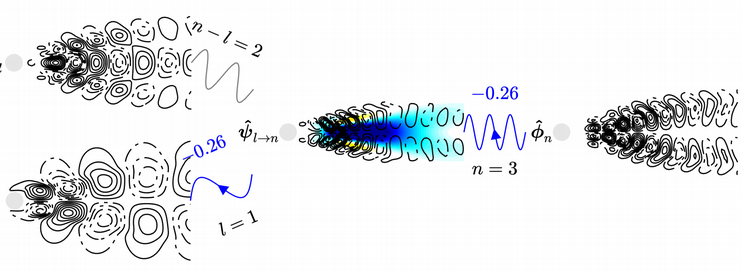
Data-Driven Energy-Transfer and Hydroacoustic Model Reduction for Stationary and Transient Naval Wakes
We align our recently developed Triadic Orthogonal Decomposition (TOD) and Space–Time POD / Space–Time Prediction (STP) tools with naval needs by delivering data-driven, physics-consistent methods for physical discovery, diagnosis, and predictive modeling of naval wake dynamics, including hydrofoils and propulsor-adjacent flows where wake evolution and vorticity interactions govern efficiency, maneuvering response, and acoustic signatures. TOD and STP are cutting-edge techniques for turbulent stationary and transient flows that provide powerful diagnostics and a direct pathway to triad-consistent, data-informed model order reduction.
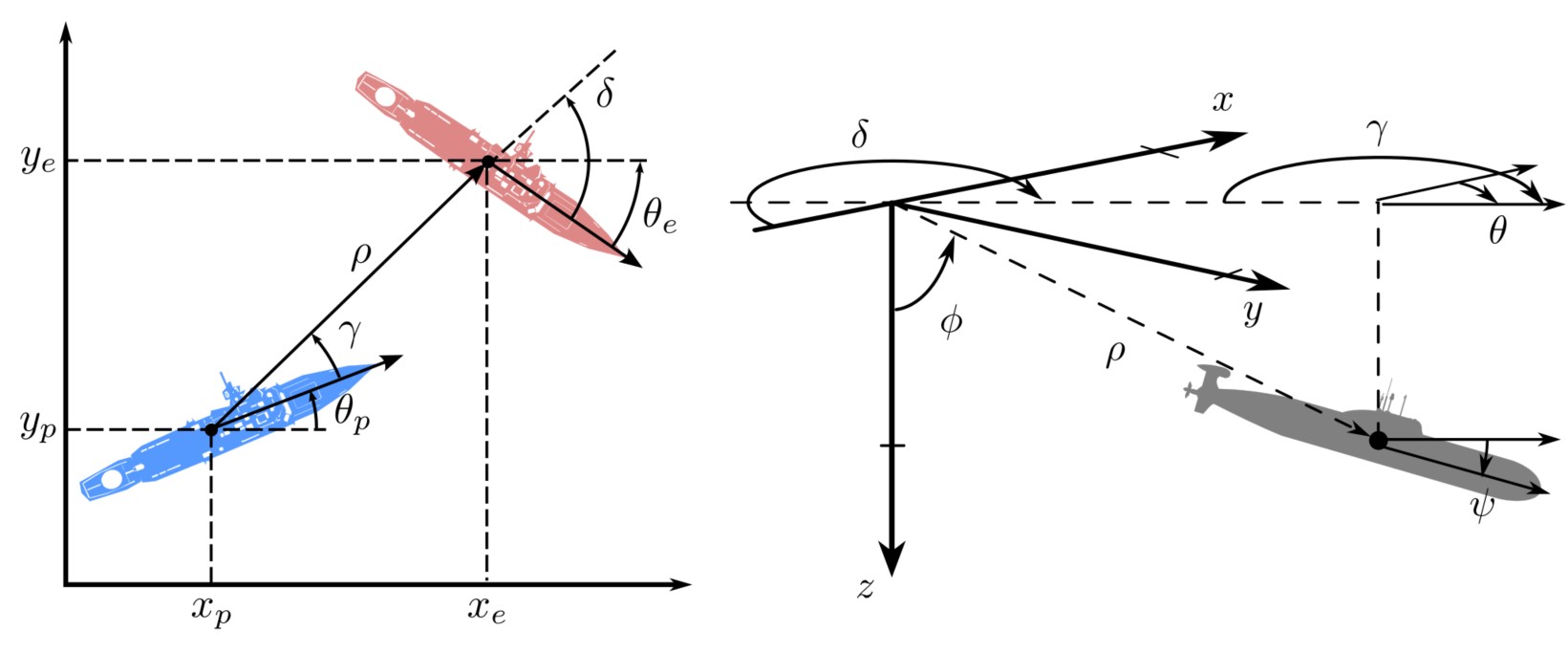
Control Designs for Marine-Surface and Undersea Vehicles Pursuing Targets, or Evading Being Intercepted
Both naval surface ships and underwater platforms are highly nonholonomic, leading to fundamental difficulties for dynamic positioning (“seakeeping”), pursuing targets, or evading pursuers and weapons. The project is developing nonlinear control strategies for achieving guaranteed intercept of marine targets, using both surface and underwater vehicles, in planar and three-dimensional settings, as well as for guaranteed evasion and escapte from pursuers. These advances support the development of autonomous maritime systems capable of robust and safe operation in dynamic ocean environments.
Hydrodynamics in the Presence of Upper-Ocean Mixed Layers
Our project focuses on the simulation of wake dynamics in density-stratified oceanic conditions, informed by field observations of nonlinear density structure and turbulence collected from emerging observational platforms. An advanced computational fluid dynamics (CFD) approach will enable the study of coherent eddy structures, internal gravity waves, and turbulence in the wake. Our research will advance the understanding of how wakes interact with the environment and will establish test case benchmarks for the CFD codes used by the Navy to design undersea platforms.
Gola, Divyanshu, S. Nidhan, J. L. Ortiz-Tarin, Hieu T. Pham, and S. Sarkar. "Disk wakes in nonlinear stratification." Journal of Fluid Mechanics 956 (2023): A5.
Internal Solitary Wave Impact on Surface Platform: A Theoretical and Numerical Study
Our project aims to quantify the hydrodynamic force caused by internal solitary waves on surface platforms, utilizing a combination of high-performance computing and potential flow theory. This endeavor seeks to deepen our comprehension of how internal solitary waves affect offshore operations, with a future goal of enhancing prediction tools that currently focus solely on ocean surface waves.
Hao, X. (2025). Inferring free surface disturbance properties from Kelvin wakes using convolutional neural network. Flow, 5, E9. doi:10.1017/flo.2025.4
Internal Wave Energy Extraction
With the goal of understanding the possibilities of an internal wave energy converter (IWEC) that extracts energy from the wavefield, we propose to study the response of submerged neutrally buoyant bodies to incoming internal waves. Our approach is to understand the underlying physical interaction mechanisms, building from simple configurations to more realistic situations. To our knowledge, this is the first attempt to look at IWECs in deep water. The current project is complementary to studies of the excitation of internal waves by translating bodies: it examines energy conversion and is designed to investigate the fundamental interaction mechanisms.
Wave Energy Conversion for Unmanned Underwater Vehicles
Our project targets development of tunable mechanisms for wave energy conversion using soft materials. Ongoing work is using numerical and laboratory experiments to explore the complex parameter space for a heave-plate energy converter, with the objective of developing a field deployable autonomous system that optimizes energy generation in realistic, variable wave conditions.
Autonomous real time source tracking and auxiliary system triggering with a low power AUV-compatible passive acoustic array
We are using an underwater acoustic data stream in combination with machine learning to passively listen for interesting sounds in the environment, and make real time decisions to trigger additional sampling. In our application, we are working to trigger a deep sea camera for still shots and video in the presence of deep diving beaked whales, which have mysterious foraging behavior as they search for prey using focused sound in deep underwater canyons. By triggering auxiliary sampling with low power autonomous listening systems, we aim to learn more about deep sea organisms, and to unlock new opportunities for multi-sensor autonomous observations of our deep ocean regions.
Underwater 3D Sensing
Three-dimensional underwater mapping is critical to many naval applications, including navigation and object detection. While 3D sensors are making rapid advancements out of water, adapting these technologies for underwater use presents significant challenges. This project combines machine learning and optical imaging to develop underwater 3D imaging sensor technologies.
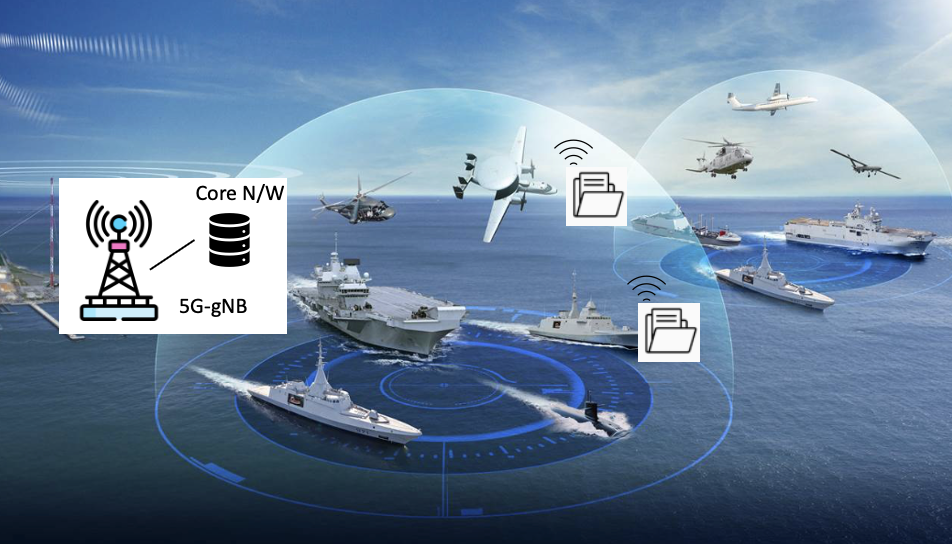
Enhancing Autonomous Naval Operations: a 5G Networking Approach for Collaborative Mapping and Mission Planning
This project aims to develop an advanced 5G networking system for naval operations that functions effectively in GNSS/GPS denied environments. Focused on enhancing naval capabilities, the system will support autonomous, collaborative mapping and mission planning across both surface and underwater assets, utilizing a network of adaptive base-station nodes that dynamically reconfigure based on their real-time locations. By integrating Open Radio Access Network (ORAN) and RAN Intelligent Controllers (RICs), the project seeks to provide customized, secure, reliable communication solutions crucial for operational efficiency and safety in naval contexts.
Bioinspired soft-swarms that move and communicate through “odd” elasticity
This project seeks to develop collective autonomous robots that self organize according to chiral physical interactions. The system is inspired from the dynamics of starfish embryos that spontaneously form chiral living crystals. We envision that this work will enable new autonomous floating platforms that can self organize and respond to local disturbances.
Safe and Adaptable Contingency Planning for Unmanned Autonomous Naval Platforms
Naval systems must plan and make decisions in the face of uncertainty over the intent and actions of other agents. To be suitable for naval applications, these decisions must be (1) fast, (2) interpretable, and (3) be paired with probabilistic safety assurances. This work seeks to develop a planning algorithm that incorporates predictions from learning-based modules, uncertainty quantification, and model-predictive control to generate a contingency plan based on the possible future actions of other agents in an environment.
Chen, Yuxiao, Sander Tonkens, and Marco Pavone. "Categorical Traffic Transformer: Interpretable and Diverse Behavior Prediction with Tokenized Latent." arXiv preprint arXiv:2311.18307 (2023).
Chemical and acoustic cues that stimulate coral reef larvae to settle on degraded and artificial coral reefs, to protect DoD assets
The overall goal is to determine to what extent underwater acoustic sounds can mediate the release of chemical nutrients or tracers from nanoparticles into the water column for coastline protection and object detection, and is divided into two phases.
Under the first phase (Summer 2024) NanoEngineering and SIO would continue to work on developing chemical and acoustic cues to enhance coral larvae settlement onto artificial reef structures, as an extension of ongoing work supported by ONR and DARPA (“REEFENSE”, Rapid Resilient Reefs for Coastal Protection). The second phase (starting Fall 2024) will develop (via simulation and lab investigation) whether low-intensity non-focused ultrasound (LINFU) can stimulate the release of chemical cues from custom biomaterial coatings that attract fish and coral larvae to artificial reef substrates. We will make use of recent advances in biomedical research to control the release of various chemical agents from nanovesicles in liposomes in response to ultrasound.
Roger, Liza, Nastassja Lewinski, Hollie Putnam, Shaochen Chen, Daniel Roxbury, Martin Tresguerres, and Daniel Wangpraseurt. "Nanotechnology for coral reef conservation, restoration and rehabilitation." Nature Nanotechnology 18, no. 8 (2023): 831-833.
Develop a multiscale multiphysics computational framework for design of new battery material systems and devices
This project develops the the particle modeling method for composite electrode, which constructs stochastic discrete element models with known particle sizes and distributions. We investigate the effects of particle mechanics on the electrochemistry of the bulk material thereby providing new insights into the material's multiscale electro-chemo-mechanics. We aim to build a new generative AI approach to design better performing battery electrodes.
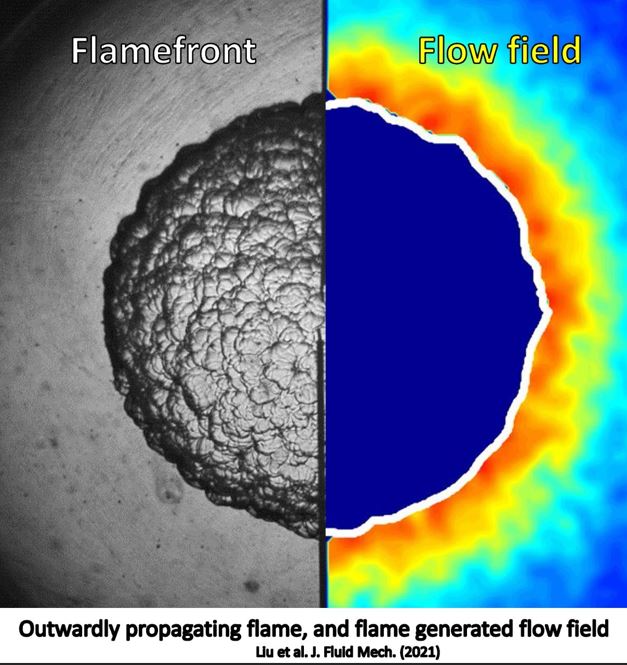
Ammonia-Hydrogen fuel blends towards decarbonization and energy resilience of naval platforms
One of the challenges in reaching the US Navy’s goal of carbon-neutral operations is eliminating CO2 emissions from the vast fleet of ships powered by IC engines and gas turbines. Switching to carbon-free fuels, such as hydrogen or ammonia, can be a solution. However, due to unfavorable thermophysical properties and combustion characteristics, burning pure hydrogen or pure ammonia in the engines is difficult. This project will assess the potential of hydrogen-ammonia blends as a possible solution by investigating the combustion characteristics in engine-relevant conditions.

Ultrasmooth Nanophotonic Materials for Super-Resolution Laser Manufacturing
Innovation in materials processing and manufacturing is intertwined with the necessity for miniaturization of material components in versatile technological applications ranging from microelectronics and transistors to sensors, photocatalysts and photovoltaics. Despite the importance of laser manufacturing, the physical limitations of conventional laser focusing pose prohibitive challenges with respect to manufacturing miniaturization, which is essential, e.g., to the development of next-generation microelectronics. This project will develop a new class of thermally robust, nanostructured materials for super-resolution laser focusing to enable laser processing and manufacturing of complex materials at unprecedented spatial resolutions, toward a multitude of miniaturized materials processing and thermal management applications.
Superconducting spintronic devices
We are pursuing a materials-centered basic research effort focused on prototyping a new generation of thin-film heterostructure devices. The goal is to combine the unique properties of superconductors and chiral magnets in devices to realize new building blocks that may enable developing higher complexity superconducting electronic applications.
Efficiently deposited, laser-annealed AlN for directional thermal management of naval relevant power electronics and systems
Thick insulating heat spreaders (>10 microns) are needed for chiplet encapsulation and interchiplet heat spreader for AI, radar, and telecommunication applications. In this project, polycrystalline aluminum nitride will be deposited by aerosol spray and well defined regions will become thermally conducting by laser annealing to fuse the AlN grains. The spray deposition is at 25C and is about 100x faster than sputter deposition.
Perez, Christopher, Aaron J. McLeod, Michelle E. Chen, Su-in Yi, Sam Vaziri, Ryan Hood, Scott T. Ueda et al. "High Thermal Conductivity of Submicrometer Aluminum Nitride Thin Films Sputter-Deposited at Low Temperature." ACS nano 17, no. 21 (2023): 21240-21250.
